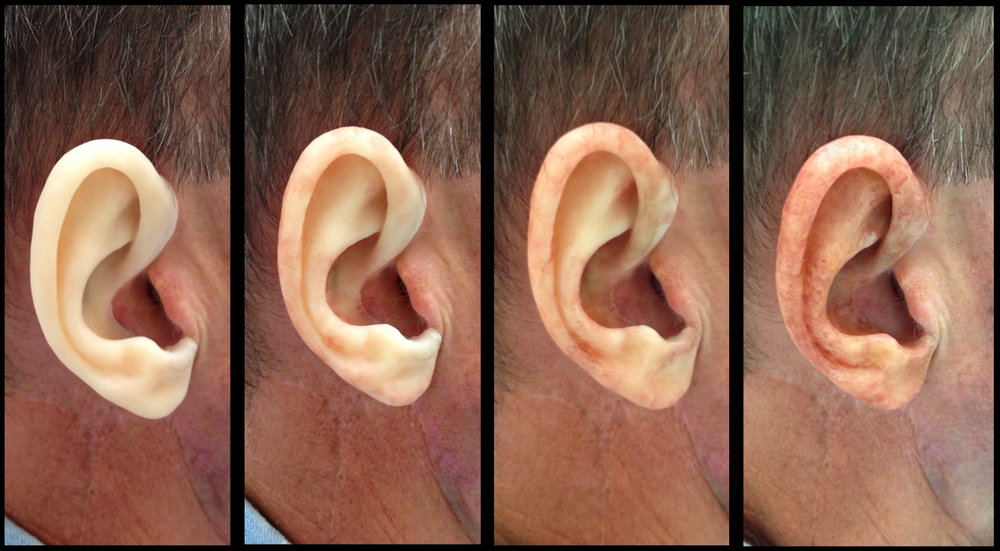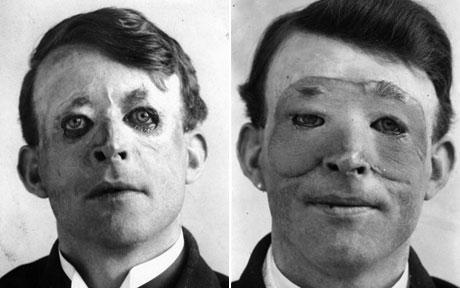The events leading up to a facial disfigurement are traumatic enough, but add to that the daily experience of being the object of curiosity because of one and it is not difficult to imagine the relief that might come with the creation of a masking prosthetic. There is a natural human tendency toward curiosity when we encounter something different and even with the best of intentions, it is very difficult to know how to react when we see something as prominent as the face presented in a unique configuration.
I remember one time meeting a man who had been very badly burned while serving in Vietnam and I was immediately paralyzed by indecision as I became conscious of the choices I made in looking at him and how they might be received. I wasn’t sure if anytime I looked at him he became newly aware of his disfigurement or if it was equally important that I not be seen looking away as that might be what conveyed an unintentional insult.Sujey Morgan is a maxillofacial prosthodontist and professor at the Tufts School of Dental Medicine and she deals with these kinds of situations every day. In her case, rather than just resigning herself to feel awkward, she decided from a very young age, after seeing the victim of a bear attack, that she wanted to dedicate herself to making a difference for people who suffered from facial disfigurement. And what she does is an amazing blend of science and art.
The prosthetics Morgan creates range from replacements for noses that have been destroyed by cancer to the creation of an ear for a child who was born without one. Once completed, the prosthetics are attached to the patient with medical glue and magnets, or in cases where there is not enough tissue to which to attach, a base is used with the prosthetic to mount it directly to implants in the patient’s skull.
This isn’t Hollywood plastic surgery to change people’s unique appearances to match some idealized image, it is assisting people with missing or deformed facial features to (re)gain some of the confidence that has also been missing or damaged. As a practice, this type of medical approach to facial disfigurement has come a long way, but is nothing new in terms of human efforts. Tycho Brahe, a Danish astronomer who died in 1601, wore a prosthetic nose made out of gold after he lost his nose in a duel. The first person to undergo what is commonly referred to now as plastic surgery was a man named Walter Yeo, a sailor who lost his upper and lower eyelids during the Battle of Jutland in 1916.
Efforts to restore the face may be ancient history, but the techniques used by Morgan in her practice are decidedly modern. She begins by creating a digital model, either of an existing part of the face, such as in the case of a boy who was missing an ear, or from some other willing model. Morgan admits that it is more often the latter approach, especially in the case of facial features lost to cancer treatments:
“Usually, when I see the patient, it’s too late. There’s no nose, so I have to create a nose. I say, ‘if you like your sister’s nose, bring her in!'”
Morgan has used 3D scanning for her three most recent patients, and has called her digital skin-color scanner her “new best friend” for the ease with which it matches skin tones. The scanning for the creation of a digital model is actually the easier part of the process. Once the model has been created, it needs to be converted into a master cast, which is then 3D printed. The cast is then further sculpted by hand to make it as true to life as possible. Once it has been fully prepared, it is filled with silicone which is then allowed to set. Once it is set, the piece requires the eye, and hand, of an artist to perfectly match the color and to add lifelike details such as pores or the veins that run through the tip of an ear.
 The introduction of scanning and 3D printing is making it easier than ever to create these types of custom prosthetics, something that is especially important because, unlike those made for lost limbs, facial prosthetics have a limited lifetime of only a year or so before they need to be replaced. As a result, many patients only use them when they go out to help them blend in with the rest of the world, Morgan explained:
The introduction of scanning and 3D printing is making it easier than ever to create these types of custom prosthetics, something that is especially important because, unlike those made for lost limbs, facial prosthetics have a limited lifetime of only a year or so before they need to be replaced. As a result, many patients only use them when they go out to help them blend in with the rest of the world, Morgan explained:
“Society can be cruel. It’s not that we mean to be, but the first thing we do when we see something weird is take a second look. It’s that second look that can traumatize these patients every day.”
Now, with the help of 3D scanning and printing technology, people who need facial prosthetics can truly go out with their best face to the world and, hopefully, cause any second looks to be because of an interest in their personality and not their appearance. What are your thoughts on this incredible work being done? Let us know in the 3D Printed Maxillofacial Prosthetics forum thread on 3DPB.com.
Subscribe to Our Email Newsletter
Stay up-to-date on all the latest news from the 3D printing industry and receive information and offers from third party vendors.
Print Services
Upload your 3D Models and get them printed quickly and efficiently.
You May Also Like
3D Printing News Briefs, July 2, 2025: Copper Alloys, Defense Manufacturing, & More
We’re starting off with metals in today’s 3D Printing News Briefs, as Farsoon has unveiled a large-scale AM solution for copper alloys, and Meltio used its wire-laser metal solution to...
Etsy Design Rule Change Reduces Selection of 3D Printed Goods
Online marketplace Etsy has implemented a rule change requiring all 3D printed goods on the site to be original designs. The update to the site’s Creativity Standards states, ¨Items produced using...
Siraya Tech Introduces New Elastomer 3D Printing Materials, Including Foaming TPU
California company Siraya Tech, founded in 2019 with a focus on material science, customer focus, and agility, develops high-quality 3D printing materials that meet the needs of creators, hobbyists, and...
3D Printing News Briefs, April 12, 2025: RAPID Roundup
The news from last week’s RAPID+TCT in Detroit just keeps on coming! That’s why today’s 3D Printing News Briefs is another RAPID Roundup of more exciting announcements from the trade...



































